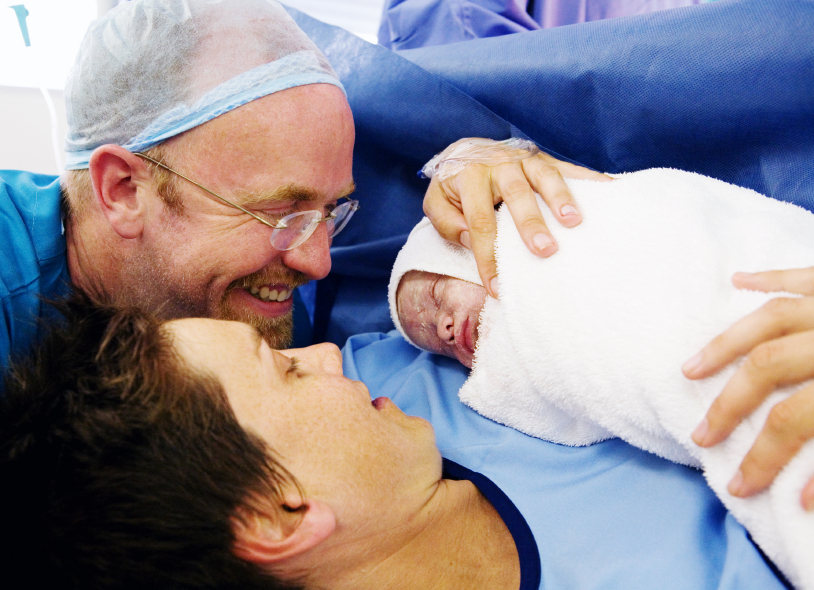Labor and birth
The first signs of labor
Labor means work. The purpose of uterine contractions is to thin and dilate the uterine cervix so that the baby may be expelled. Consequently contractions are working to expel the baby. Labor begins when the mucus plug is expelled and uterine contractions become regular and increasingly more painful. Sometimes leakage or spontaneous rupture of the bag of waters may help bring on labor.
Expulsion of the Mucus Plug
The expulsion of the mucus plug is an inconstant finding in the mechanism of labor. Formed by mucosal secretions inside the uterine cervix, sometimes tinged with blood, this plug forms a barrier to infection. It may be expelled 24 to 48 hours prior to childbirth, or even several days before. It may go unnoticed if it occurs at the same time as rupture of the bag of waters or cervical dilation.
Uterine Contractions
Just as any muscle, the uterus can contract. Such contractions are not under voluntary control, and all you can do is experience them. They sometimes develop during the 5th month and are painless, or may not start until the onset of labor. When uterine contractions become regular and painful, they herald the start of labour, regardless of the duration of the gestation. Uterine contractions cause the wall of the uterus to become hard. This is easily felt by a hand placed on the abdominal wall during a contraction. As the cervix is being dilated and its opening stretched during a contraction, discomfort grows increasingly strong.
Sometimes limited to the lumbar region, discomfort generally begins in the lower back, divides in half, encircling the abdomen to come together again around the pelvis. Each contraction is separated from the succeeding one by periods of relief. It may occur, especially with a first child, that contractions become immediately regular, recurring every five minutes. Their rate which at first is progressive, every fifteen, ten, and then every five minutes accelerates. They then become increasingly more painful with shorter and shorter periods of pain relief.
Effects of Uterine Contractions
As a result of the work done by contractions, the cervix softens, decreases in length and shortens, eventually being incorporated into the body of the uterus while at the same time remaining closed. The rate of such contractions, i.e. recurring less than every ten minutes, alerts you to go to the maternity ward.
The baby gradually descends the birth canal depending on cervical dilation and can only leave the uterus after the cervix is completely dilated. As discomfort becomes more intense, you should inhale as soon as a uterine contraction occurs, and exhale slowly until the pain subsides. Between contractions you should retain all your strength, and should remain calm to surmount this massive test of physical endurance.
Rupture of the bag of waters
The outflow of about a glassful of warm aqueous fluid corresponds to rupture of the bag of waters, while a leakage gives the impression of urinary incontinence. In both cases, this flow, with or without uterine contractions, and sometimes tinged with meconium, should alert you to go to the emergency admissions of the maternity hospital to avoid infection of the amniotic cavity.
Pain relief during labor
We all experience and express pain differently. While there's no denying that labor is painful, there's no way to measure the pain. Needless to say, after delivery, when you see your child, the pain is forgotten about. Some women insist on a drug free labor, and some demand whatever is on offer. Most take the middle ground, preferring to do it naturally, but reserve the right to change their minds if the going gets really tough.

Physical Therapy
Physical therapy helps many women cope with pain. You can try:
- Massage
- Heat walking
- Showering
- Bathing
- Rocking in a chair
- Squatting on a birthing ball
Pain Relief Medication
The two most common forms of pain relief are nitrous oxide inhalant, which is given as a gas, and pethidine, which is given intravenously or with an injection into the buttocks, when labor is advanced, but well before delivery. Sometimes tranquilizers are used to calm an anxious woman so she can participate more fully in childbirth. There are also several different types of anesthesia available, ranging from general anesthesia (for cesarean birth) to regional nerve blocks, which numb only a small area.
Epidural
Epidural anesthesia offers longer-acting pain management without affecting the baby. In an epidural, an anesthesiologist will numb a small area of your lower back and insert a catheter through a needle into the space surrounding the spine. Through the catheter, medication can be inserted continuously throughout labor. An epidural will numb you from the waist down, virtually taking away the pain. If you're thinking about an epidural, don't wait too long to ask for it. You'll need to receive intravenous fluids before the epidural can be started, which takes about 30 minutes.
Making the Decision
Labor is unpredictable.
Until you're there, you won't know whether you'll want pain relief medication. And if one technique doesn't work, you may want to try another. So find out as much as you can by talking to your doctor or midwife about the options available at your hospital.
Delivery : Vaginal
In a routine vaginal delivery, your first view of your child may be the top or crown of his head seen with the help of a mirror. After the head is delivered, the obstetrician will suction the nose and mouth, and your baby will take his first breath. He doesn't need to be slapped or spanked to begin breathing, nor will he necessarily cry; many newborns take their first breath quietly.
With the most difficult part of the birth now over, there is usually one last pause before the push that sends the rest of your child's body, which is smaller than his head, gliding smoothly into the doctor's waiting arms. After another, more thorough suctioning of his nose and mouth, your child may be handed to you to hold and behold.
Even if you've seen pictures of newborns, you're bound to be amazed by the first sight of your own infant. When he opens his eyes, they will meet yours with curiosity. All the activity of birth may make him very alert and responsive to your touch, voice and warmth. Take advantage of this attentiveness, which may last for the first few hours. Stroke him, talk to him and look closely at this child you've created.
Recovery from Vaginal Delivery
Just as every woman and baby is unique, so too is their labor and delivery experience. How well you recover after a vaginal delivery will depend on a number of factors. The overwhelming feeling most women are consumed with immediately after a vaginal delivery is fatigue. The level of fatigue you experience may depend in part on your overall health and well being, the number of hours of labor endured and how much rest you had prior to labor.
Most women will go through a period of both physical and emotional adjustment after delivery. How long it takes you to get back on your feet after giving birth will depend on a number of factors, including the degree of tearing and overall labor experience. For most women a relatively uncomplicated birth will result in a rapid recovery.
If however, you spend a large portion of your pregnancy on bed rest or if for example, you had a difficult birth it may take some time for you to feel 'normal' again.
How much energy you have after labor will also depend on whether this is your first child or not. If you have other children to care for, you will probably be more exhausted for a longer period of time after labor.
Pregnancy and delivery require a physical and emotional period of adjustment. For many women the physical recovery is often considered the easier of the two. Emotionally your body will go through a number of changes, including rapid fluctuations in hormones. In addition, taking on the role and challenges of motherhood may take some time adjusting to.
It is recommended that you wait six weeks before having intercourse after delivery, to allow your body to heal physically from the effects of labor and delivery. Your doctor may also suggest that you avoid any heavy exercise for the same period of time, and may advise you not to drive for a few days to a couple of weeks after delivery.
Every woman is unique, and every woman's recovery experience will be different.

Delivery : Cesarean section
The term "cesarean" is derived from the latin word "caedere" meaning "to cut." Cesarean section is a surgical operation which has minimum risks for both mother and baby. Babies born by cesarean section, that is, extracted by surgically incising the mother's uterus, are identical to babies born by vaginal delivery. It is rather the mother who may regret missing the natural delivery of her baby.
Signs which motivate cesarean section include:
- Previous cesarean sections due to a pelvic abnormality
- Breech presentation or any other presentation making childbirth difficult
- Disproportion between the baby's head and the pelvic inlet which make vaginal delivery impossible;
- Toxemia of pregnancy not responsive to medical therapy requires prompt delivery to protect mother and baby.
- Placenta previa or an abnormally-inserted placenta in the lower uterine segment: if the placenta partially or completely covers the internal os, cesarean section is required. Cases of placenta previa can be diagnosed by ultrasound performed before labor starts, or during dilation of the cervix.
- A retroplacental hematoma or toxemia of pregnancy, especially with bleeding or foetal distress.
- In case of postdatism refractory to induction, when the expected date of delivery has absolutely passed. In such instances, the placenta stops providing nutritional material necessary for the fetus.
- Hypertension, depending on its severity, can be the reason for a cesarean.
- Lack of progression of labor as a result of contractions that are not effective despite infusions of oxytocin, and documented adequacy on a tocometer.
- Fetal distress determined by electronic monitoring of the fetus; a cesarean section can then become necessary.
A cesarean section in a primipara does not mean that it must be repeated for a second or subsequent delivery.
If a cesarean is performed because of fetal distress, you can usually hope to have a vaginal delivery in a subsequent pregnancy. But if the cesarean was necessary because of a chronic disorder or an abnormality in pelvic morphology, you will likely require another cesarean. Another cesarean can be planned cautiously, based on your obstetrician's strict advice.

Breech presentation
3 to 4% of pregnancies involve breech presentation. In a complete breech, the baby appears to be sitting with hips and knees flexed. In incomplete breech presentation, the baby's legs and feet are raised towards his chin and the foetal buttocks present. The physician establishes this diagnosis during the physical examination, but many babies who are in breech presentation during the 7th month of pregnancy will become cephalic without any intervention.
Attempts at version
Breech birth generally takes longer and should only be permitted when the physician is certain that the baby's head will easily emerge; external version can be attempted to help the baby's head emerge first.
Version is performed with ultrasound control and monitoring of the foetal heart sounds when there is ample fluid, and the baby can still be turned with nothing to maintain him in this position. However, it can happen that the day after successful external version, the baby once again returns to breech presentation! This manipulation can fail, if for example, the umbilical cord is too short, or there is inadequate fluid. For the above reasons, it is not universally accepted.
Vaginal delivery or Cesarean
Whether attempts at external version fail, or breech presentation is accepted for the birth of the baby, the decision on cesarean section or vaginal delivery should be made before childbirth, and it depends on your doctor's comfort level and whether the baby's head, emerging last, can deliver easily.
The size of the head, its biparietal diameter, the position of the chin flexed against the chest are then evaluated on ultrasound, and compared with the diameter of the mother's pelvis. The pelvis may be measured by radiopelvietry or adequacy may be confirmed by digital examination and delivery of prior babies of acceptable size.
Breech birth
With any traction exerted on the breech, there is a possible risk that the baby's head will flex or even raise his arms. An inopportune digital examination can induce premature breathing. Thus, procedures are limited to making certain that the baby's back is in front, or to lower the baby's arm if it hinders his descent through the birth canal. At the right time, the mother is asked to bear down and push with all her might.
Upon emergence of the baby, he often resumes the position which he adopted in his mother's uterus, with his cute head rounded and black and blue marks on his genitalia resulting from the stress of delivery. On rare occasions, the baby's head may become entrapped, which is dangerous to the newborn. This complication should be discussed with your doctor.

